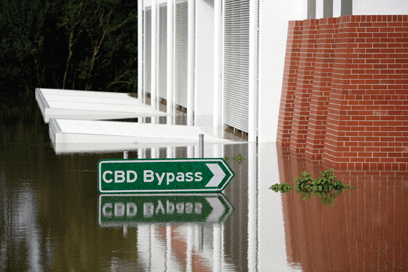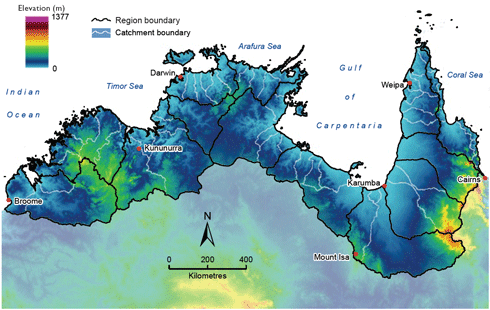
|
Published:
Building resilience. Adapting to climate impacts
Organisations and communities each face different challenges in adapting to climate change effects. Experts have differing perspectives on where effort should be focused – distinctions that are part of the complexity of adaptation planning – but they agree that steps to minimise risks need to be taken.

|
|
Cape Byron, at Byron Bay, NSW. The Byron Shire Council has one of the country’s most proactive climate adaptation strategies for the future of its coastal community. Credit: iStockphoto
|
If climate change mitigation strategies involve reducing greenhouse gas emissions, adaptation strategies focus on building resilience to climate change effects.
While adapting to changing circumstances is at the heart of long-term planning in business, government and natural resource management, planners are confronted with the challenge of having too much data related to climate impact scenarios, but not enough clarity on what actually needs to be done.
‘There is misunderstanding and confusion about climate change and how to deal with it in both business and the wider community,’ believes Sam Mostyn, a member of Australian National University’s Crawford School Advisory Council and Director of Myer-ClimateWorks. ‘People think it’s an event yet to happen; they are waiting for some “big thing” to occur, and then they will react to that.
‘There needs to be far greater transparency of what’s actually changing and how that will impact business and communities,’ she continues. ‘For example, insurance data about the frequency and ferocity of weather events provides good insight into changes in storm patterns, wind speeds, floods, hail storms and bushfires.
‘Understanding where these events are likely to happen will help us make decisions about whether existing infrastructure can tolerate these extreme weather events, or whether residential
and commercial building codes need to
be strengthened – it then becomes a local and state government policy issue.’
Mostyn identifies that there are also a lot of benefits to recognising the potential for change in an area and being the first to take advantage of the opportunities that presents, whether it be, for example, in tourism, agriculture or even construction.
Dr Ben Preston, a research scientist with CSIRO Marine & Atmospheric Research, is working with stakeholders to understand climate risk and find pathways to adaptation.
‘While there is still a lot of uncertainty about exactly what the effects of climate change will be at a local level, we can face this uncertainty in two ways,’ he says. ‘We can scratch our heads, or we can provide leadership and employ precautionary policies, such as planning for sea-level rise by legislating for increased setbacks in coastal areas.
‘We can’t look at climate projections alone; we have to look at the characteristics of whole systems – whether ecosystems, agricultural production systems or urban communities.
‘Like ecosystems that are threatened by encroachment from development or invasive species, those geographic areas or systems already under pressure for other reasons will fare worst,’ he says.

|
|
Lightning strikes during a storm over Sydney. Credit: iStockphoto
|
Liam Egerton, senior consultant with sustainability consultancy Net Balance, agrees. His company is developing a framework for resilience that, among other things, focuses on building adaptive capability along with managing risk thresholds, the tipping points that can lead to runaway changes in a system.
‘Risk assessment on climate changes can produce a long list of potential impacts and their likely consequences. It doesn’t say how they’re linked, or detail the dependencies between them,’ he says, ‘but by looking at how a system holds together, rather than just managing risk, we can better understand its ability to withstand shocks.’ In other words, its resilience is considered.
This means the analysis has to go far beyond the biophysical impacts, he says. For example, the military uses scenarios to test how people’s lives are impacted by biophysical changes, and their results have been illuminating. ‘They indicate that climate change is a significant security problem, due to the knock-on effects on the system as a whole.’

|
|
Floods inundated Lismore, NSW, during October 2008. Credit: iStockphoto
|
Dr Preston believes that social and economic trends will have a larger influence on the future of our communities than climate change and its biophysical impacts. One focus of his research involves working with local government organisations to overlay a map of national climate change vulnerability with data about social and economic trends affecting a community.
‘While it makes sense to focus our efforts on the areas where wealth, economic activity, capability and knowledge are centred, there is an equity issue – we also need to target those areas that are least capable of helping themselves.
‘We are looking at things like population growth, ageing and measures of social disadvantage, because in a protracted heatwave, for example, an area with a large population of impoverished older people will be more sensitive to its effects than a more affluent area.’
This example highlights the opportunity for adaptation and mitigation strategies to work together, he says. ‘By greening urban landscapes and ensuring that buildings are appropriately designed for the climate, the impacts of a heatwave are reduced. There are also much longer term benefits associated with reduced energy consumption for heating and cooling.’
It then becomes a governance issue. ‘Local governments are generally implementing policy decisions handed down by state legislation, so in this sense state government legislation can really inhibit or enhance the ability of communities to adapt to change.’
He says local governments also have an important role in communicating with and educating their constituents, building their capacity to respond. Early warning systems for heatwaves, floods and bushfires will also help reduce impacts of extreme events.
‘Adaptive management is simply good management,’ says economist Dr Stefan Hajkowicz, Theme Leader – Sustainable Regional Development at CSIRO Sustainable Ecosystems. He is not concerned about business adaptation, arguing that there is already a huge amount of adaptation in the marketplace. He cites reduced energy and water consumption, changed insurance premiums and the abandonment of unfeasible agricultural practices as examples of market force-driven climate change adaptation.
‘The economy is already adapting where it needs to. We need to look at where we’re failing.’ He is focusing on how to target scarce resources to protect environmental assets, and says we face some tough decisions.
‘We need to have some sense of what we want to protect before climate change gets any worse,’ he says. ‘We are going to have to take a triage approach and give up some assets to protect others. If we don’t face that now we won’t have the resources to protect what matters most.
‘Science provides an evidence-based approach for making decisions, but at the end of the day, it is the Australian people who need to decide whether they want to protect the Great Barrier Reef or whether they want to divide that same purse of resources across many more smaller projects.
‘Whatever decision is made, there will be consequences; for tourism, jobs, whole communities and the economy. It’s the elephant in the room, but we need to start a dialogue about prioritising the best use of scarce resources.’
Ben Preston concurs. ‘The best approach to climate change adaptation is to take the knowledge that we already have and translate that to real action.’
More information:
Climate Adaptation National Research Flagship, http://www.csiro.au/org/ClimateAdaptationFlagship.html



